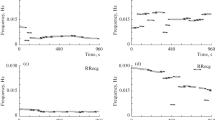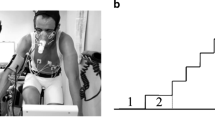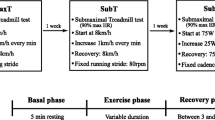Summary
The “steady state” of exercise is only relatively steady; considerable fluctuation in the rate of oxygen consumption occurs from minute to minute. The standard deviations expressed in per cent of mean O2 consumption are smallest with a moderate work load which requires a certain effort and concentration of the subject; they are greater at either extreme of work load. The instability of the “steady state” of exercise appears to be a normal phenomenon.
Similar content being viewed by others
References
Lukin, L., andH. J. Ralston: Oxygen deficit and repayment in exercise. Int. Z. angew. Physiol.19, 183–193 (1962).
Ralston, H. J.: Energy-speed relation and optimal speed during level walking. Int. Z. angew. Physiol.17, 277–283 (1958).
Author information
Authors and Affiliations
Additional information
This investigation was supported by research grant GM-08013 (Principal Investigator: Dr.Verne T.Inman) from the National Institutes of Health, U. S. Public Health Service.
Rights and permissions
About this article
Cite this article
Lukin, L. Instability of the “steady state” during exercise. Int. Z. Angew. Physiol. Einschl. Arbeitsphysiol. 20, 45–49 (1963). https://doi.org/10.1007/BF00693566
Received:
Issue Date:
DOI: https://doi.org/10.1007/BF00693566




